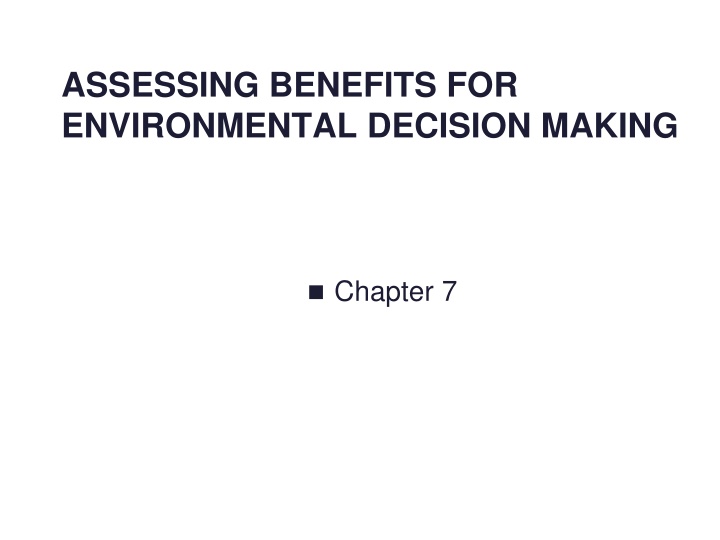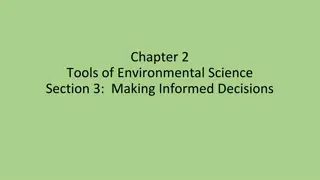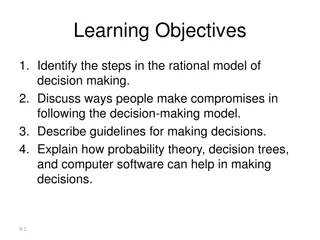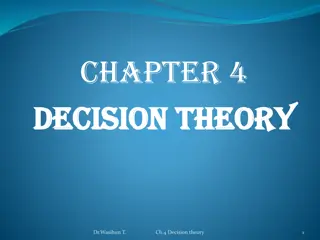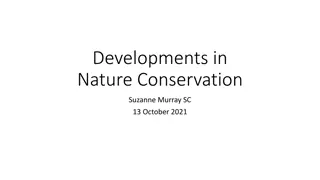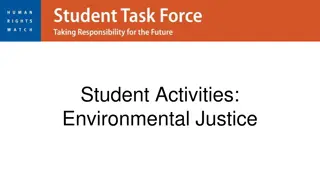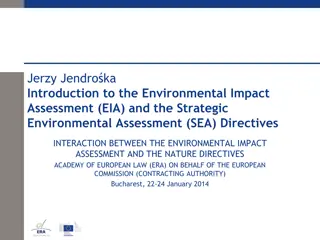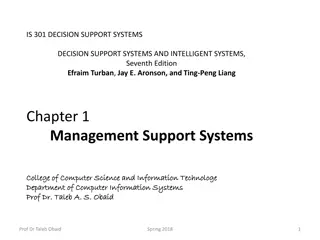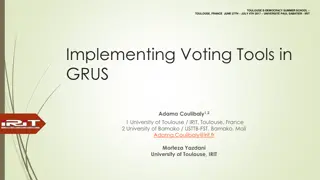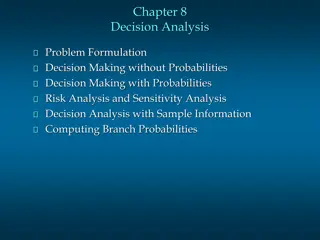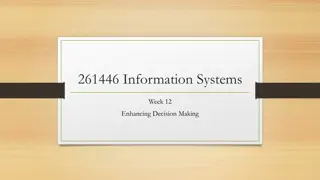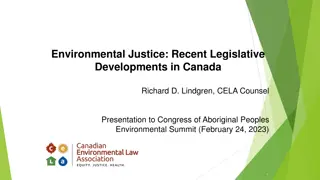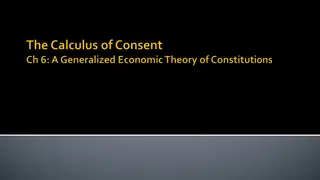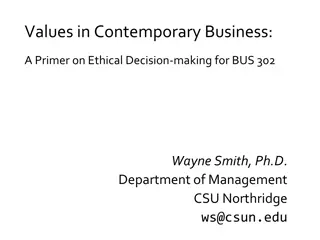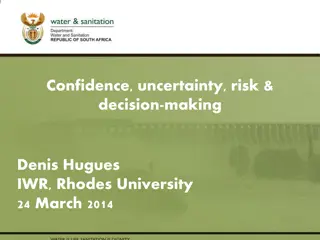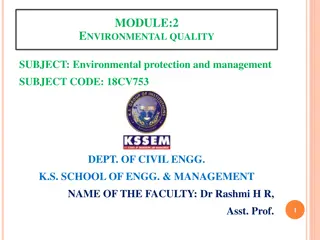Assessing Benefits for Environmental Decision Making
This chapter delves into the conceptual issues and types of incremental benefits in environmental decision making. It explores how to assign and model incremental benefits using various approaches such as MSB and TSB, providing insights into the valuation of environmental quality for informed policy decisions.
Uploaded on Feb 18, 2025 | 0 Views
Download Presentation

Please find below an Image/Link to download the presentation.
The content on the website is provided AS IS for your information and personal use only. It may not be sold, licensed, or shared on other websites without obtaining consent from the author.If you encounter any issues during the download, it is possible that the publisher has removed the file from their server.
You are allowed to download the files provided on this website for personal or commercial use, subject to the condition that they are used lawfully. All files are the property of their respective owners.
The content on the website is provided AS IS for your information and personal use only. It may not be sold, licensed, or shared on other websites without obtaining consent from the author.
E N D
Presentation Transcript
ASSESSING BENEFITS FOR ENVIRONMENTAL DECISION MAKING Chapter 7
Assessing Benefits Conceptual Issues Environmental benefits measure damage reductions Policy brings about changes in these damage reductions, yielding incremental benefits Incremental benefits are the reduction in health, ecological, and property damages associated with an environmental policy initiative 2
Types of Incremental Benefits Primary benefits Damage-reducing effects that are a direct consequence of implementing environmental policy Examples: lower incidence of respiratory problems, more stable ecosystems, more prosperous fishing industry Secondary benefits Indirect gains to society that may arise from a stimulative effect of primary benefits or from a demand-induced effect to implement policy Examples: higher worker productivity due to improved health, increased demand for labor to implement a policy 4
Assign Value to Incremental Benefits Since environmental quality is a public, non-marketed good, Demand cannot be identified because of nonrevelation of preferences But if we could infersociety s Demand (or MSB) for environmental quality, we could measure incremental benefits as follows: Area under MSB is Total Social Benefit (TSB) Changes in TSB would be incremental benefits 5
Modeling Incremental Benefits Find baseline TSB before policy Find new TSB after policy is implemented Subtract baseline from new TSB 6
Modeling Incremental Benefits (using MSB) MSB = 25 - 0.3A 25 Incremental Benefits = $91.25 million 19.0 MSB ($millions) 17.5 D = MSB 0 20 25 A (abatement %) 7
Modeling Incremental Benefits (using TSB) Incremental Benefits = $91.25 million TSB 531.25 440.0 TSB ($millions) TSB = 25A - 0.15A2 0 20 25 A (abatement %) 8
Valuing Environmental Quality Two Sources of Value Total value = User value + Existence value User value is the benefit derived from physical use or access to an environmental good Direct user value is the benefit derived from directly consuming services provided by an environmental good Indirect user value is the benefit derived from indirect consumption of an environmental good Existence value is the benefit received from the continuance of an environmental good Motivated by: Vicarious consumption: when individuals value a public good for the benefit it provides to others Stewardship: sense of obligation to preserve the environment for future generations and recognition of its intrinsic value 9
Two Major Approaches to Measuring Benefits Physical linkage approach Estimates benefits based upon a technical relationship between environmental resource and user of resource Behavioral linkage approach Estimates benefits using observations ofbehavior in actual markets or survey responses about hypothetical markets 10
Overview of Methods Physical Linkage Approach Damage Function Method Behavioral Linkage Approach Direct Method Contingent Valuation Method Indirect Methods Averting Expenditure Method Travel Cost Method Hedonic Price Method 11
Damage Function Method Specifies a relationship between a contaminant (C) and some observed total damage (TD) Estimate benefits as TD declines from the policy-induced change in C 12
Damage Function Model Damage reduction in nonmonetary terms Damage function TD0 TD1 Suppose policy causes a decline in the contaminant from C0 to C1 0 C1 C0 Contaminant (C)
Assessing the Damage Function Method Estimates only one type of incremental benefit at a time Represents only a first step, since it is not capable of simultaneously monetizing the damage reduction that it identifies 14
Example Suppose a U.S. policy reduces pollution damage to crops, resulting in a higher crop yield as an incremental benefit Model as an increase in supply (S) Measure the incremental benefit as: (consumer surplus (CS) + producer surplus (PS)) 15
Incremental Benefits $ S0 a Incremental benefit = ebc S1 b P0 P1 c e D Q of corn 0 Q0 Q1
Contingent Valuation Method (CVM) Direct Method under Behavioral Linkage Approach
Contingent Valuation Estimates benefits from survey responses about WTP for environmental quality contingent upon hypothetical market Valuing recreational quality of beaches or parks, preservation of wildlife species and ecosystems, toxic waste disposal, etc. Valuing reductions in health risks Valuing a statistical human life Suppose an environmental policy lowers the risk of death from 2 in 100,000 to 1 in 100,000 exposed U.S. EPA: $8 million value of a human life saved 18
Contingent Valuation Steps: Identify and describe the environmental quality characteristic or health outcome to be evaluated Identify respondents to be approached, including using sampling procedures to select respondents Design and application of survey Aggregate individual responses and analyze results to estimate values 19
Contingent Valuation Examples First used in 1963 by Bob Davis to estimate the benefits of outdoor recreation opportunities in the Maine backwoods Modal WTP per family for the use of a wilderness recreation area was between $1 and $2 per day Brookshire and Coursey (1987) used CV to determine WTP for a change in tree density in an urban park from 200 to 250 trees per acre Showed pictures of the park with different tree densities Median WTP among their respondents was $9.30 Stevens et al. (2004) used CV to estimate the benefits people would receive from reduced damages due to air pollution from power plants in the White Mountains of NH Showed a series of computer-generated photos of a view with varying degrees of visibility (for different levels of pollution control) For moderately improved visibility, WTP ranged from $3 to $12
Assessing Contingent Valuation Broad applicability Can capture existence as well as user value Inherent biases due to survey approach May be unwilling to reveal WTP because of free rider problem May have difficulty assigning a dollar value WTP can differ from WTA (willingness to accept) 21
Willingness to Pay vs. Willingness to Accept WTP: Maximum amount you would be willing to pay to avoid degradation WTA: Minimum amount you would be willing to accept to compensate you for degradation WTA estimates are usually higher than WTP, especially for large (non-marginal) changes WTA is not constrained by income 22
Averting Expenditure Method (AEM) Indirect Method under Behavioral Linkage Approach
AEM Estimates benefits as the reduction in spending on goods that are substitutes for a cleaner environment As pollution damages the environment, people incur averting expenditures to improve their personal environment This spending is reduced as policy improves the overall environment This spending reduction is an estimate of the WTP for associated incremental benefits 24
Modeling AEM Define overall environmental quality (E) The relevant market for study is personal environmental quality (X) D is MB; S is MC or averting expenditures MC0 of X0 is linked to a given level of E0 As the overall environment improves, or as E increases from say, E0 to E1, the individual incurs lower costs, so MC shifts right from MC0 to MC1 andX0 improves to X1 Change in spending for the same level of X isan estimate of incremental benefits 26
Modeling AEM abd is WTP for improvement in E based on achieving X0 (acts as a lower bound) $ MC0 (based on E0) b MC1 (based on E1) c d a D = MB 0 X0 X1 Personal environmental quality (X)
Modeling AEM abc is WTP for improvement in E based on achieving X1 $ MC0 (based on E0) E rises to E1 b MC1 (based on E1) c d a D = MB 0 X0 X1 Personal environmental quality (X)
Assessing the AEM Problem of jointness of production Some AE yield benefits other than those from improving environmental quality e.g., air conditioning provides comfort as well as filters the air 29
Travel Cost Method Indirect Method under Behavioral Linkage Approach
TCM Estimates benefits as an increase in consumer surplus (CS) in the market for a complement to environmental quality (i.e., recreational use), as policy improves that quality As policy improves the environment, the Demand for recreational use of the environment increases, causing an increase in CS This CS increase is the benefit estimate 31
Modeling TCM Market is recreational services of lake Original CS = abP0 New CS = cdP0 CS = abcd c a Policy improves lake s quality so D increases d Price line P0 b D1 D0 0 V0 V1 Number of Visits (V)
Assessing the TCM Estimates only user value (not existence value) Addresses only recreational use (not useful for estimating commercial benefits) Estimates are biased downward if access to site is congested 33
Hedonic Price Method (HPM) Indirect Method under Behavioral Linkage Approach
HPM The benefits to living in a less polluted area extend beyond avoided cost of illness A hedonic price analysis can account for the value of not only health impact but also other benefits of living in a less polluted area 35
HPM Uses estimated hedonic,orimplicit,price of an environmental attribute to value a policy-driven improvement e.g., PHOUSE = f(X1, X2, .Xn, E), where: each Xi is an attribute of the house, and E is the environmental quality in the area Hedonics uses regression analysis, which provides estimates of the prices of the individual attributes, including E 36
Assessing the HPM Logical, intuitive Difficult to employ Requires complex empirical modeling Requires extensive data Must have variation across data points. 38
